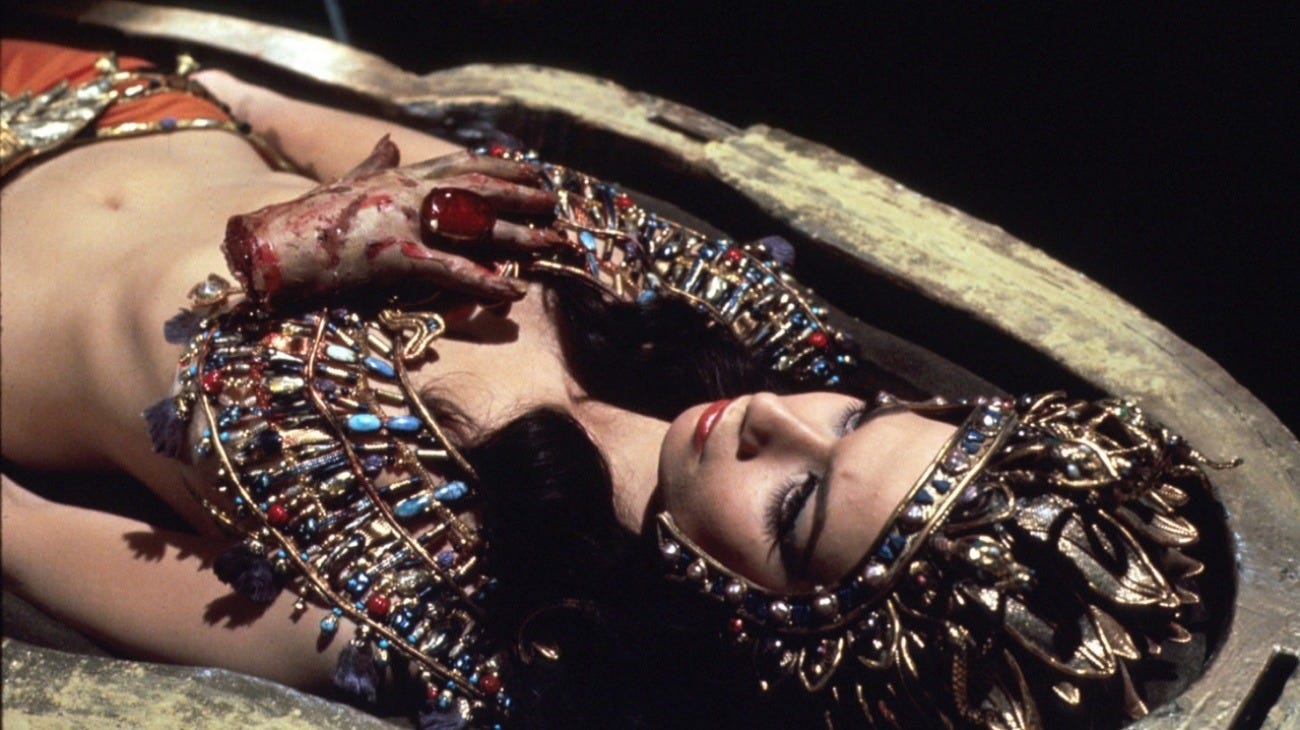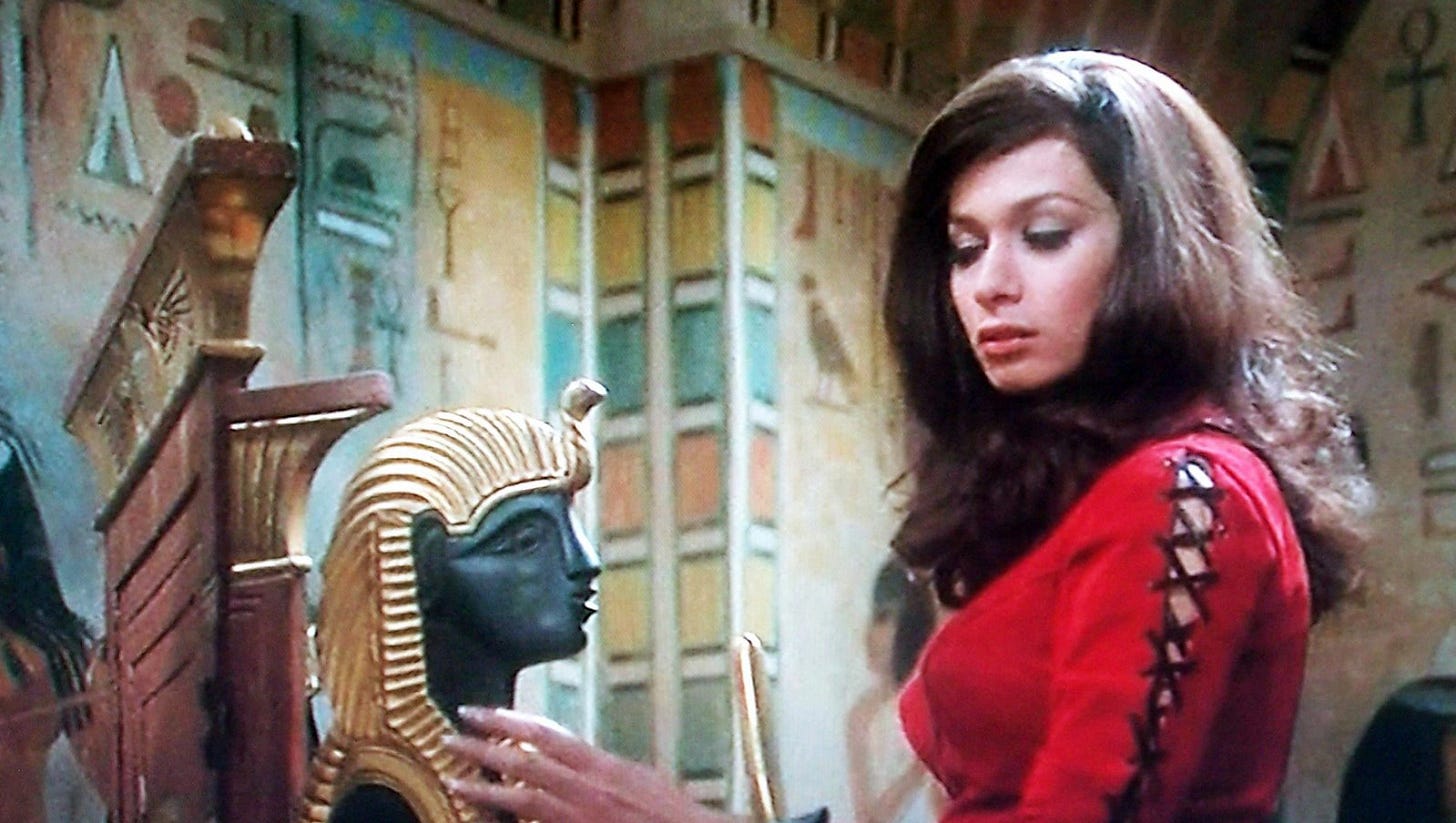We Don't Need Another Mummy
Excavating Hammer's gem of a movie, Blood from the Mummy's Tomb
Although The Mummy (1959), was one of the trio of films starring Christopher Lee and Peter Cushing that launched Hammer Horror and put the struggling Hammer Films on the international map, their subsequent mummy movies never caught on the way their Dracula and Frankenstein movies did. Maybe it was the lack of a marquee star the caliber of Lee or Cushing (however good André Morell may have been). Maybe it was the repetitive nature of the plots (even more so than the average Dracula or Frankenstein picture). Maybe people just weren’t that into mummies in the 1960s. Whatever the case, after that initial entry, Hammer’s mummy movies were strictly part of the B-team, though at least there were a few of them—which is more than can be said for Hammer werewolves. Apart from that initial entry, however, the only Hammer mummy that gets much critical respect is their final mummy movie, which came near the end of the company’s lifespan and, ironically, contains no mummies (or at least no reanimated ones).
After three Hammer mummy movies, which already followed many Universal mummy movies featuring the vengeful bag o’ rags known as Kharsis, the general consensus was that the world pretty much had all the movies it needed in which some expedition disturbs a tomb, gets yelled at by a guy in a fez, and then gets stalked by the mummy looking to avenge the desecration of the tomb and hook up with the reincarnation of his long lost love. Even in as few as three films (the others being 1964’s The Curse of the Mummy's Tomb and 1967’s The Mummy's Shroud), Hammer Studio seemed to be flogging a dead…I don’t know…Pharaoh or something?
By 1971, nothing at Hammer was going well. The company was suffering financially and creatively and found itself unable to keep up with changing trends in horror (which had shifted away from those lush old Gothics and toward modern-day thrillers about devil children). Despite the dire straights in which Hammer found itself, however, in the early 1970s they made a number of surprisingly good films that, while still operating within the existing framework of Hammer Horror, tried to do things a little differently. Two of the three “Karnstein” vampire films — Vampire Lovers and Twins of Evil are excellent, even if the middle piece of the loosely connected series, Lust for a Vampire is somewhere more on the dodgy end of things. Vampire Circus was highly enjoyable and unique, and Captain Kronos: Vampire Hunter was a spirited blending of vampire horror and swashbuckling adventure. Even Frankenstein and Dracula tried some interesting variations on their hoary old themes.
Somewhere amid those death throes that allowed fun, inventive films to slip into production, someone decided to give the mummy another go (again—just no love for werewolves at Hammer). However, with Blood from the Mummy’s Tomb, certain changes were to be made. First and most obvious there was no mummy, at least not the shambling cloth-wrapped mummy one expects. Second, the script, based on the short story “The Jewel of Seven Stars” by Bram Stoker, did contain a curse, the violation of a tomb, and the deaths of all who entered said tomb, but there was no vengeance for the desecration. In fact, the expedition, it turns, out, was guided there purposely by the entombed princess within. Third, rather than being set in the usual 1860-1910 range of dates that encompassed most of Hammer’s horrors, Blood from the Mummy’s Tomb sports a modern setting. This was a bit off-the-rails (if extremely entertaining) when they tried it in Dracula A.D. 1972, but it works well in Blood from the Mummy’s Tomb since there was no effort to beat people over the head with funky music and bell-bottoms and guys using crazy hep cat lingo. It just meant that someone drove a car and wore a turtleneck sweater.
That Blood from the Mummy’s Tomb is such an enjoyable film is impressive given the fact that it became known as one of those “cursed” films (too bad they used up the “curse” title for the second film). The trouble started with Peter Cushing, who in an attempt to return some degree of prestige to the flagging mummy movies was cast as an archaeologist pitted against an ancient Egyptian princess who wants to reincarnate using the body of his daughter. With only a day or so of filming under his belt, however, Cushing’s wife grew very ill, and he wanted to be by her side. She died shortly thereafter, and Cushing was in no mood to be making mummy movies about dead women trying to return from the tomb. Hammer was more than willing to let their main man grieve, so into the role stepped Andrew Keir, a fine actor who worked with the company on such productions as Dracula, Prince of Darkness and Viking Women, and was probably best known for playing the title character in Quatermass and the Pit. Even though losing Cushing was a blow, Keir was a top-notch talent who, if not as recognized as Cushing, was still a familiar and well-respected face.
Unfortunately, that wasn’t the only tragedy to befall the film. Director Seth Holt (who had directed Hammer’s delightfully nutty 1965 thriller The Nanny, starring Bette Davis), an imaginative director with a unique style, died during filming. He was replaced with Michael Carreras, the son of Hammer founder James Carreras. Michael’s directorial filmography was uneven. He wasn’t exactly the studio’s star director unless you’re idea of Hammer at its best was Lost Continent and Prehistoric Women. But I guess they figured with Curse of the Mummy’s Tomb under his belt, they might as well call him in and let him direct the bits of Blood from the Mummy’s Tomb that remained unfinished.
Blood from the Mummy’s Tomb is about ancient Egyptian princess Tara (Valerie Leon), who is put to death in sort of half-assed fashion for just being kind of all-around wicked. The method of execution seems to be to put some BBQ sauce in her nose and then cut off her hand, the reasoning being that if her body remains incomplete, she can never rise from the tomb to inflict her evil on society again. You’d think that rather than just chopping off a hand and throwing it to the jackals, you’d also do the head, maybe a leg. You know, make a thorough job of things. As it is, not only do they only chop off her hand, but that hand manages to kill a jackal, summon a sandstorm, and rip out the throats of all the murderous priests.
This movie will feature a lot of gory blood-gushing neck wounds, by the way. In terms of gore, it’s somewhat extreme for Hammer. In the 1950s and early 1960s, Hammer was notorious for pushing the limits of acceptable onscreen gore. However, the revolution they began eventually passed them, and by the time of Blood from the Mummy’s Tomb, Hammer films seemed quaint and reserved compared to what was being pulled in other films. Blood from the Mummy’s Tomb isn’t a gorefest, but the gushing neck wounds are pretty shocking, and the finale of the film features a really juicy stabbing.
Centuries later, visions of the execution plague young Margaret (also Valerie Leon). Her father was part of an expedition that unearthed Tara’s tomb and are baffled to find her corpse perfectly preserved and looking no older than the day she was killed. Things get weirder when they discover her corpse and her severed hand still bleed, but they’re not able to get too freaked out since she also seems to be working some mojo from beyond the grave that puts the archaeologists under her spell. Each of them takes one of her sacred items, and when the items are united on her birthday, her spirit will return to earth and possess Margaret. Unfortunately, Margaret is already falling under the spell of the ghostly princess. See, her father gave her this big, ugly, unsightly red ring that allows Tara to possess Margaret. Although most of the members of the expedition resist Tara’s demands, that just results in Valerie summoning up ghastly forces to inflict more neck wounds.
What makes the film work, aside from it being different than the mummy movies that came before it, is the quality of the cast. Valerie Leon had small parts in a lot of those Carry On films the British seemed to love so much and later appeared in two James Bond films. Blood from the Mummy’s Tomb was one of her first starring roles. Chris Wicking’s script certainly helps, but it’s the dedication of the players that makes it all work. Of course, that’s the case for just about all the Hammer films, and more than a few spotty scripts were saved by the fact that the cast commits to it entirely and makes you believe. Blood from the Mummy’s Tomb isn’t a spotty script, so the fact that the cast is into it makes it even better.
Hammer’s 1970 entry into their long-running Dracula series, Taste the Blood of Dracula, was originally conceived as a story about people who worship the cult of Dracula or form his extended vampire family, but in the end, distributors demanded Dracula show up, so there he is, must to the consternation of Christopher Lee, who made a career out of bad-mouthing his Hammer Dracula movies (I guess he did some other stuff, too). I guess they were less concerned about a mummy movie without a mummy in it, so Blood from the Mummy’s Tomb leans into its possession, ghosts, and psychological horror—which was more in keeping with the trend of the time anyway (which had been realigned by 1968’s Rosemary’s Baby). It has more in common with its continental cousins, trading the clinical approach of old Hammer for something stranger and more similar to Italian and French horror and cinema fantastique. It relies more on mood and psychological tension than the visceral thrills for which Hammer had become infamous a decade earlier and has a dreamy/nightmarish atmosphere that is uncanny but not shocking—except, of course, for the parts where blood spurts out of something.







